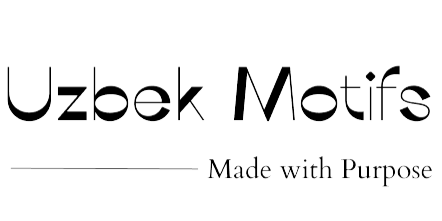"If I could see only one kind of art for the rest of my life, it’s easy.
Textiles. Uzbekistani textiles. No question about it."
What is it Uzbek Ikat or Abrbandi?
Uzbek Ikat, known in Uzbekistan as Abrbandi, is not really the type of fabric.
To put simply, "Ikat" and "Abrbandi" are related textile techniques, both involving tie-dyeing,
but they have some distinctions ( read more about Ikat and Abrbandi correlation and differences in our blog post here).
"Ikat" is more wider term and includes "Abrbandi" as one of its type.
"Abrbandi" a term associated with the traditional textile art of tie-dyeing, particularly in the context of Central Asian and Persian cultures.
The term "abrbandi" is of Persian origin, where "abr" means cloud and "bandi" means binding or tying.
Therefore, "abrbandi" translates to "cloud binding" or "cloud tying."
In the context of textile arts, Abrbandi refers to a technique in which fabric threads are tied or bound in specific patterns before dyeing.
This process creates unique and intricate patterns on the fabric, resembling the irregular shapes and patterns of clouds.
The tied sections resist the dye, resulting in a distinct and often blurred pattern when the fabric is woven.
Uzbek ikat - "Abrbandi" - is renowned for its rich colors, intricate designs, and cultural significance.
The fabrics are often used to create traditional garments, home textiles, and accessories.
The combination of traditional craftsmanship and vibrant designs makes Uzbek ikat
a sought-after and culturally significant textile in the region and beyond.
What is unique about Uzbek Ikat?
-Uzbek Ikat - Abrbandi - is recognized by UNESCO as an intangible cultural heritage of humanity-
-Uzbek Ikat fabrics and garments are part of numerous private and museum collections-
-Uzbek Ikat fabrics are made to last and, without exaggeration, will pass from generation to generation-
1- Firstly, there's a chance that colors may bleed, although this is less problematic with modern fabrics.
To mitigate this risk, it is advisable to hand wash ikats in cold water with a mild detergent.
2- Secondly, washing may lead to a loss of shape.
For effective care of ikat fabrics, consider the following guidelines:
- Wash in cold water using mild detergent.
- It is advised to use shampoo as a laundry detergent (tip from Uzbek Ikat makers :)
- Ensure Ikat fabric is washed separately from other items.
- It is also recommended to dd a pinch of salt in the water to preserve the color.


